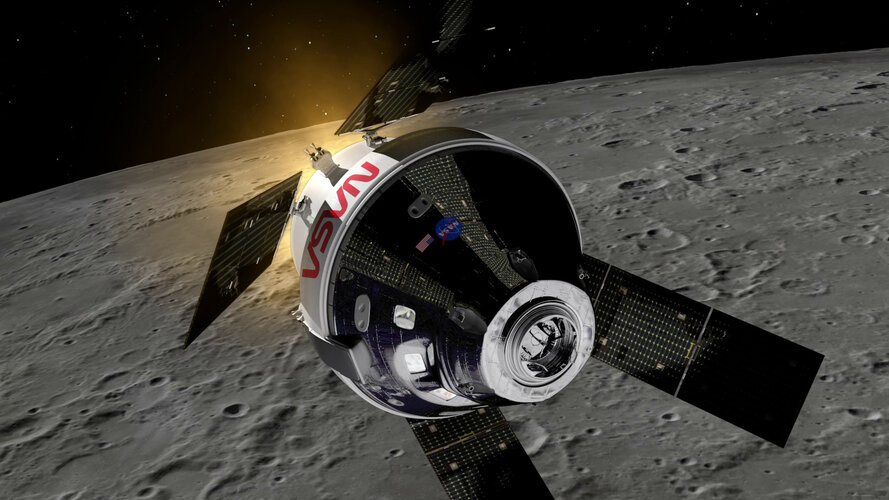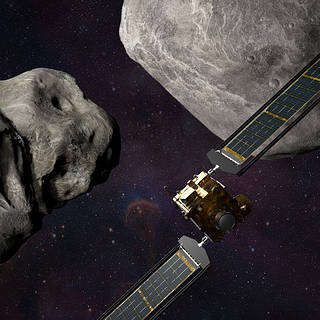
Copernical Team
'Long time coming': NASA 'a go' for launch of Artemis test mission to moon
 NASA says it's set to launch the first test flight Monday of its long-anticipated mission that will return U.S. astronauts to the moon for the first time in 50 years.
The Artemis 1 mission is scheduled for liftoff from Kennedy Space Center in Florida after 8:30 a.m. Monday within a two-hour window, the agency said in a briefing Monday.
The mission is the first test of the newly m
NASA says it's set to launch the first test flight Monday of its long-anticipated mission that will return U.S. astronauts to the moon for the first time in 50 years.
The Artemis 1 mission is scheduled for liftoff from Kennedy Space Center in Florida after 8:30 a.m. Monday within a two-hour window, the agency said in a briefing Monday.
The mission is the first test of the newly m Europe to support Artemis CubeSats in return to the Moon

Drought causes Yangtze to shrink
 Image:
A record-breaking drought has caused parts of the Yangtze River to dry up – affecting hydropower, shipping routes and limiting drinking water supplies. Images captured by the Copernicus Sentinel-2 mission show a comparison of the Yangtze and Jialing rivers, near Chongqing, over the last three years.
Image:
A record-breaking drought has caused parts of the Yangtze River to dry up – affecting hydropower, shipping routes and limiting drinking water supplies. Images captured by the Copernicus Sentinel-2 mission show a comparison of the Yangtze and Jialing rivers, near Chongqing, over the last three years. An overview of NASA's Artemis 1 mission to the Moon

NASA's Artemis 1 mission, scheduled to take off on Monday, is a 42-day voyage beyond the far side of the Moon and back.
The meticulously choreographed uncrewed flight should yield spectacular images as well as valuable scientific data.
Blastoff
The giant Space Launch System rocket will make its maiden flight from Launch Complex 39B at Kennedy Space Center in Florida.
Its four RS-25 engines, with two white boosters on either side, will produce 8.8 million pounds (39 meganewtons) of thrust—15 percent more than the Apollo program's Saturn V rocket.
After two minutes, the thrusters will fall back into the Atlantic Ocean.
After eight minutes, the core stage, orange in color, will fall away in turn, leaving the Orion crew capsule attached to the interim cryogenic propulsion stage.
All systems go for Artemis 1 mission to Moon

Fifty years after the last Apollo mission, the Artemis program is poised to take up the baton of lunar exploration with a test launch on Monday of NASA's most powerful rocket ever.
The goal is to return humans to the Moon for the first time since the last Apollo mission in 1972—and eventually to Mars.
The 322-foot (98-meter) Space Launch System (SLS) rocket is scheduled to blast off at 8:33 am (1233 GMT) from the Kennedy Space Center (KSC) in Florida.
The mission, more than a decade in the planning, may be uncrewed, but is highly symbolic for NASA, which has been under pressure from China and private rivals such as SpaceX.
Hotels around Cape Canaveral are booked solid with between 100,000 and 200,000 spectators expected to attend the launch.
The massive orange-and-white rocket has been sitting on KSC's Launch Complex 39B for a week.
ESA technology for safer, smarter European roads

An agreement signed yesterday looks to extend the use of ESA space technology along European roads. The Agency’s Navigation Directorate has finalised a Memorandum of Intent with ERTICO, the organisation for the European Road Transport Telematics Implementation Coordination, a public-private partnership focused on the development, promotion and connection of intelligent road systems and services.
NASA 'go for launch' for planned Artemis I moon mission

With a week to go before the Artemis I rocket has its first shot at the moon, NASA managers said the hardware is good to go.
The massive Space Launch System rocket and Orion spacecraft atop the mobile launcher rolled out to Kennedy Space Center's Launch Pad 39-B last week ahead of the first launch window that opens at 8:33 a.m. next Monday.
"We are go for launch," said NASA Associate Administrator Bob Cabana after teams completed the flight readiness review Monday. "This day has been a long time coming. ... I want to put this in perspective. This is a test flight. It's not without risk. We have analyzed the risk as best we can and we have mitigated as best we can."
The rocket launch expected to bring between 100,000 and 200,000 spectators to the Space Coast will if successful become the most powerful rocket to ever lift off from Earth. The core stage combined with two solid rocket boosters produce 8.8 million pounds of thrust besting the Saturn V rockets from the Apollo missions to the moon.
NASA Invites Media to Witness World’s First Planetary Defense Test
 NASA’s Double Asteroid Redirection Test (DART), the world’s first mission to test technology for defending Earth against potential asteroid or comet hazards, will impact its target asteroid—which poses no threat to Earth—at 7:14 p.m. EDT on Monday, Sept. 26.
NASA’s Double Asteroid Redirection Test (DART), the world’s first mission to test technology for defending Earth against potential asteroid or comet hazards, will impact its target asteroid—which poses no threat to Earth—at 7:14 p.m. EDT on Monday, Sept. 26. La NASA invita a la prensa a la primera prueba de defensa planetaria
 La misión Prueba de redireccionamiento del asteroide doble (DART, por sus siglas en inglés) de la NASA, la primera en el mundo que pone a prueba una tecnología para defender a la Tierra de posibles peligros de asteroides o cometas, impactará con su objetivo, un asteroide que no supone ninguna amenaza para la Tierra, a las 7:14 pm EDT del lunes 26 d
La misión Prueba de redireccionamiento del asteroide doble (DART, por sus siglas en inglés) de la NASA, la primera en el mundo que pone a prueba una tecnología para defender a la Tierra de posibles peligros de asteroides o cometas, impactará con su objetivo, un asteroide que no supone ninguna amenaza para la Tierra, a las 7:14 pm EDT del lunes 26 d Saturn V was loud but didn't melt concrete

The Saturn V carried man to the moon and remains the most powerful rocket to successfully launch to orbit. It captures the imagination—but sometimes, it might capture a bit too much imagination. Abundant internet claims about the acoustic power of the rocket suggest that it melted concrete and lit grass on fire over a mile away.
Such ideas are undeniably false. In The Journal of the Acoustical Society of America, researchers from Brigham Young University used a physics-based model to estimate the acoustic levels of the Saturn V. They obtained a value of 203 decibels, which matched the very limited data from the 1960s.
To put that number into perspective, commercial jet engines range from around 120 to 160 decibels.
"Decibels are logarithmic, so every 10 decibels is an order of magnitude increase," said author Kent L.
